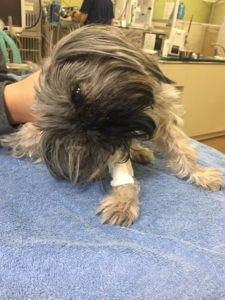While alarming to watch, vestibular disease is a common condition in dogs and cats (and rabbits and ferrets, too), and is very similar to vertigo in humans. An inner ear imbalance can cause incoordination, turning, leaning, or even falling and rolling.
In both vestibular disease in animals and vertigo in humans, the balance organs in the right and left inner ears lose synchronization, causing the brain to think the body should be turning. The most common signs of vestibular disease are head tilt, nystagmus (eye twitching), and incoordination. Because the brain thinks the body and head are turning, the vomit centers in the brain may also be activated, causing nausea.

“Animals with vestibular disease can feel profoundly dizzy because their brain is telling them they’re spinning while their eyes are telling them they’re not,” said Dr. Amanda Cavanagh, urgent care veterinarian at the Colorado State University Veterinary Teaching Hospital. “Sometimes animals will continuously alligator roll until they get stuck somewhere.”
Nystagmus usually has a directionality, whether it is horizontal, vertical, diagonal, or rotary/twisting, and is also often the first sign to improve as the rest of the brain relearns normal behavior. Incoordination may include falling, drifting, leaning, and rolling. Usually these behaviors occur in one direction over the other.
Occasionally when signs first appear, the dog or cat may appear nauseated. This usually diminishes after a few hours, even though the nystagmus, turning, and incoordination may persist.
Sometimes other signs of brain disease can occur alongside vestibular signs, so if your animal is experiencing signs of vestibular disease, talk to your veterinarian to get a proper diagnosis.
Causes
There are many underlying causes that can trigger vestibular disease, and there are even several classifications of the disease itself.
“We group diseases based on which part of the vestibular system is affected,” said Dr. Lisa Bartner, veterinary neurologist at the hospital.
Peripheral vestibular disease happens when the peripheral nervous system, including the inner ear balance organ and the vestibular nerve, is involved. Central vestibular disease involves the central nervous system components, including the brain stem and cerebellum.
The two most common causes of peripheral disease in dogs are inner ear infection and “Old Dog” or idiopathic vestibular disease.
“If your dog is prone to ear infections, this may be a likely cause if they are exhibiting signs of vestibular disease,” Bartner said. “However, if your dog is getting up there in age – usually over nine years old – this may be an indication of idiopathic vestibular disease.”
Cats are also commonly affected by inner ear infections and idiopathic vestibular disease. Ear polyps are another cause of peripheral disease in cats. Tumors in cats and dogs may also impact the peripheral nervous system.
Causes of central vestibular disease are more variable but include strokes, tumors, autoimmune, infections, toxins, and medications.
Peripheral vestibular disease can look just like central disease and vice versa, which is why it is crucial to seek veterinary evaluation if your pet shows these signs.
Testing
Your veterinarian may request routine blood work or perform a physical exam to help with diagnosis. Imaging offers a more detailed evaluation of the anatomy and disease. While X-rays of the skull offer little diagnostic detail and are generally not fruitful, advanced imaging such as CT or MRI provides very useful information. Occasionally a spinal tap or deep ear cleaning is recommended to investigate microscopic disease.
Treatment
Treatment for vestibular disease almost always includes supportive care. If the patient is nauseated, antiemetic medication may be beneficial to prevent vomiting. If your pet cannot walk without falling, hospitalization is recommended for intravenous fluid support to prevent dehydration. If the patient is mobile, monitoring at home is appropriate. Supportive measures at home include using a towel or sling to provide extra support while walking and taking care on slippery surfaces. Elevating food and water bowls to shoulder height can be helpful to limit the need to lean forward; this change in head position could make vestibular signs worse. Lastly, leaving a night light on helps navigation in a dimly lit environment, as dogs and cats rely on their visual input and sense of touch.
Treatments for specific diseases will depend on the underlying condition. Your veterinarian will help guide this decision-making.
Prognosis
The best prediction for prognosis is based on the condition causing vestibular signs. For idiopathic vestibular disease, most dogs will start improving over several weeks, and many make a full recovery. Generally, the nystagmus is the first sign to resolve, indicating the rest of the brain is adapting. The head tilt is the most common sign to persist and often worsens, especially during stressful times, and then improves when the animal relaxes again.
Signs of vestibular disease can range from very subtle to severe and are understandably highly distressing for pet families to experience. However, the outward appearance does not always reflect the cause or severity. Many conditions could result in vestibular signs, some of which are benign, but prompt and appropriate evaluation by a veterinarian is necessary when an owner first notices any abnormality.